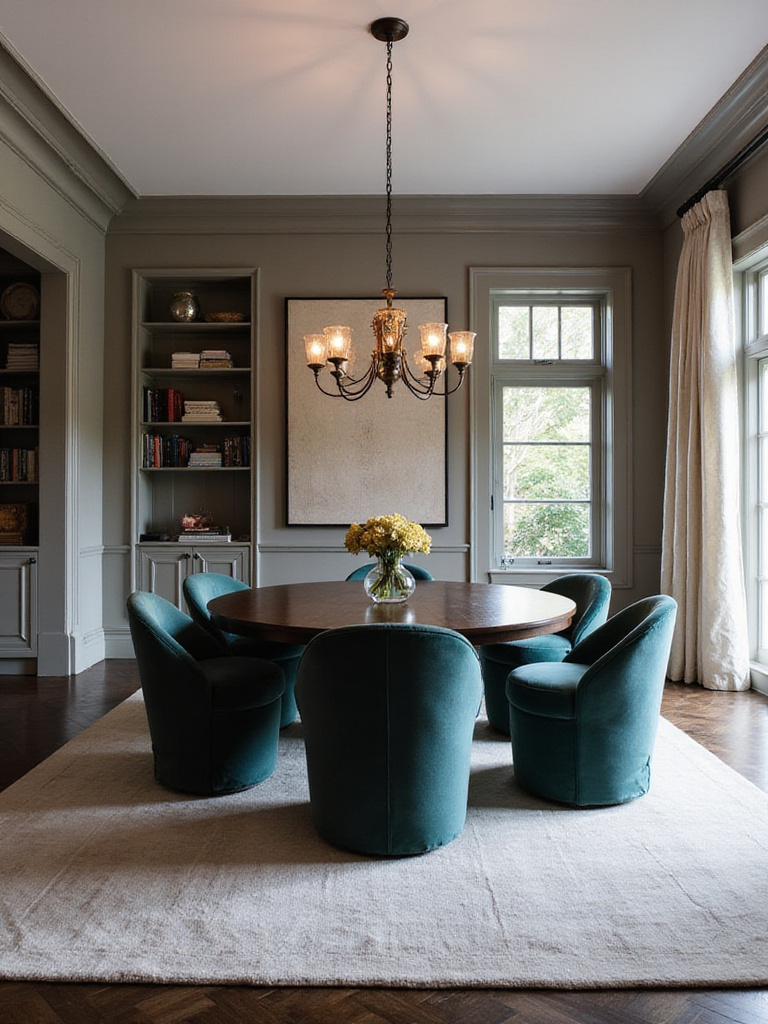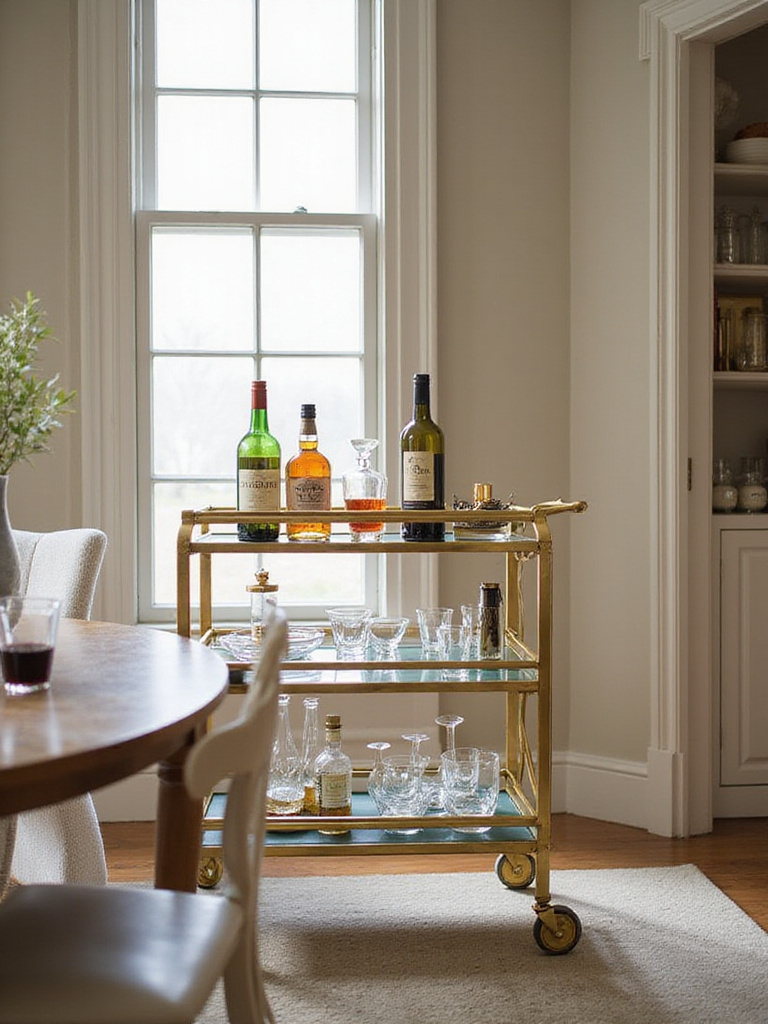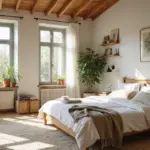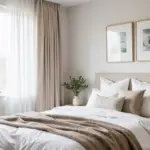The dining room transcends its utilitarian purpose, becoming the stage where life’s most intimate conversations unfold between spoonfuls of soup and sips of wine. It’s where children announce academic triumphs, where friends reconnect after years apart, and where families navigate the day’s highs and lows over steaming plates of comfort food.
Yet many of us neglect this vital space, letting it become merely functional rather than truly inspired. Whether you have a dedicated dining room or a modest corner in an open floor plan, these 23 ideas will help you create a space that beckons people to linger, to share, to connect. Let’s transform your dining experience from ordinary to extraordinary.
1. Choosing the Ideal Dining Table Shape & Size
The inspiration for this collection struck when I realized how profoundly table shape influences not just aesthetics, but the very nature of our interactions. Rectangular tables create a subtle hierarchy, with heads positioned at either end—perfect for formal gatherings or when you want to establish clear roles. Round tables, by contrast, democratize the dining experience, placing everyone at equal distance and naturally facilitating conversation flow.

For practical sizing, allow 24 inches of table width per person and ensure at least 36 inches between the table edge and walls or furniture. This gives diners enough elbow room and allows for comfortable movement around the space. A 48-inch round table comfortably seats four, while a 60-inch version accommodates six. For rectangular options, a 72-inch table seats six, while 96 inches works well for eight diners.
The visual weight balances perfectly when you choose a table that respects your room’s proportions—neither overwhelmingly large nor disappointingly diminutive. Before committing, outline your prospective table’s dimensions with painter’s tape on the floor to visualize its presence in your space.
2. Setting the Mood with Perfect Dining Room Lighting
The magic of this piece lies in its ability to transform the entire emotional landscape of your dining experience. Lighting isn’t merely functional—it’s the invisible architect of atmosphere, capable of turning Monday’s leftovers into an occasion or making a holiday feast feel truly extraordinary. The right illumination flatters both your food and your guests, creating a glow that encourages connection.

Implement a three-layer approach: ambient lighting provides general illumination, task lighting focuses on the table surface, and accent lighting highlights architectural features or artwork. The centerpiece typically hangs 30-36 inches above the table surface for standard 8-foot ceilings (add 3 inches for each additional foot of ceiling height). Choose fixtures scaled appropriately—about one-half to two-thirds the width of your table prevents the fixture from dominating the space.
The unexpected environmental benefit comes from installing dimmers on all dining room lighting sources. Beyond creating ambiance, dimmers reduce energy consumption and extend bulb life. This simple addition gives you complete control over the mood, allowing you to transition from bright family breakfasts to intimate dinner conversations with a simple adjustment.
3. Selecting Comfortable and Stylish Dining Chairs
What makes this design special is the way comfort and style must dance together in perfect harmony. A visually stunning chair that leaves guests shifting uncomfortably after twenty minutes fails its primary purpose, while a comfortable chair that clashes with your aesthetic disrupts the visual flow you’ve worked to create. The ideal dining chair supports extended conversations and lingering meals.

Consider these key elements:
- Height relationship: Aim for 10-12 inches between seat and tabletop
- Seat width: At least 17-20 inches for comfortable seating
- Seat depth: 16-18 inches supports proper posture
- Back support: Slightly angled backs (about 100-110 degrees) provide optimal comfort
- Height relationship: Aim for 10-12 inches between seat and tabletop
- Seat width: At least 17-20 inches for comfortable seating
Materials impact both aesthetics and practicality. Upholstered chairs offer comfort but require more maintenance in food-adjacent environments. Wooden chairs provide durability and timeless appeal but may need cushions for extended seating. Metal introduces industrial elements while maintaining clean lines.
The craftsmanship reveals itself in details like joinery quality, upholstery pattern alignment, and finish consistency. Before purchasing, physically sit in the chairs when possible—comfort is subjective and what works for one body may not work for another. Remember that these pieces will witness countless conversations, celebrations, and everyday moments.
4. Defining the Space with an Area Rug
The environmental story behind this piece began with understanding how rugs transform acoustics. Hard dining room surfaces—tables, chairs, flooring—create echo chambers that amplify the clatter of cutlery and the cacophony of conversation. A well-chosen rug absorbs sound, creating a more intimate auditory experience that encourages meaningful exchange rather than shouting across the table.

Proper sizing is crucial—your rug should extend at least 24 inches beyond all sides of the table, ensuring chairs remain on the rug even when pulled out. This prevents awkward transitions and potential tripping hazards. For a standard 6-person rectangular table, aim for a rug approximately 8′ x 10′. Round tables pair beautifully with round or square rugs that maintain at least 24 inches of coverage beyond the table edge.
Many homeowners wonder how to balance beauty with practicality in this high-traffic, high-risk spill zone. Look for low-pile rugs in darker patterns that disguise inevitable marks. Materials like wool naturally repel stains and clean easily, while indoor/outdoor rugs offer exceptional durability. A quality rug pad underneath prevents slipping while adding cushioning and extending your rug’s lifespan—a worthwhile investment for this dining room inspiration cornerstone.
5. Incorporating Functional and Beautiful Storage
The designer’s secret here is to recognize that storage pieces do far more than simply contain your dining essentials—they establish visual weight and architectural presence in the room. A substantial buffet or sideboard anchors the space, creating balance with your table and providing crucial horizontal surface area for serving, displaying, and lighting.

When selecting these pieces, consider both interior and exterior functionality. Look for adjustable shelving to accommodate various item heights, drawers with dividers for organizing flatware, and perhaps dedicated storage for linens or special occasion serveware. The exterior should provide a display surface approximately 36-42 inches high—ideal for buffet service, lamps, or decorative objects that contribute to your dining room inspiration.
The sustainable journey of this material involves choosing pieces built to last generations rather than temporary solutions. Quality sideboards and buffets often become family heirlooms, carrying stories and memories alongside your grandmother’s china. Consider solid wood construction with proper joinery, dovetailed drawers, and quality hardware that will withstand decades of use. These investment pieces often appreciate in both monetary and sentimental value.
6. Adding Personality with Wall Art and Decor
The interplay between the colors creates conversation starters and visual interest that elevate everyday dining experiences. Wall art serves as the room’s personality center, expressing your aesthetic sensibilities and creating atmosphere that complements the physical experience of dining. Rather than selecting generic pieces, choose art that provokes thought or evokes emotions you want present during meals.

Scale matters significantly—undersized art appears lost and insignificant, while oversized pieces can overwhelm the space. A general guideline: art should occupy about two-thirds to three-quarters of the wall space above furniture. For dramatic dining room inspiration, consider a gallery wall mixing various media, sizes, and frames to create a collected-over-time appearance. Alternative wall decorations like sculptural elements, wall sconces, or even decorative plates can introduce dimension beyond traditional framed art.
Beyond aesthetics, the ecological impact matters because thoughtfully selected art creates lasting satisfaction, reducing the tendency toward frequent redecorating. Consider supporting local artists whose work speaks to you personally rather than mass-produced pieces that will likely feel dated within a few years. Art that resonates deeply becomes part of your home’s story rather than merely temporary decoration.
7. Using Color to Create Atmosphere
Look closely and you’ll notice the subtle texture of color psychology at work in the world’s most memorable dining spaces. Warm hues like terracotta, amber, and cinnamon stimulate conversation and appetite—there’s a reason so many restaurants incorporate red. Cool tones like sage, slate, and navy create sophisticated, calming environments that encourage lingering over multi-course meals. Your color choices actively shape not just how your dining room looks, but how it feels to gather there.

Consider these strategic approaches:
- Monochromatic schemes using variations of one color create sophisticated, cohesive spaces
- Complementary colors (opposite on the color wheel) generate energy and visual interest
- Analogous palettes using adjacent colors produce harmonious, relaxing environments
- Neutral foundations with strategic color accents offer flexibility and timelessness
- Monochromatic schemes using variations of one color create sophisticated, cohesive spaces
- Complementary colors (opposite on the color wheel) generate energy and visual interest
The material sourcing makes all the difference in how your colors present throughout the day. Natural pigments in quality paints respond beautifully to changing light conditions, while cheaper options can appear flat or shift in unappealing ways. Test colors on multiple walls and observe them at different times before committing.
While trendy, this element has staying power because color remains the most transformative and cost-effective dining room inspiration available. A thoughtfully chosen palette can make a small dining space feel more expansive, a cavernous room more intimate, or a dark space more luminous—all without structural changes.
8. Bringing the Outdoors In with Plants and Greenery
The artisan collective that creates these pieces works primarily with oxygen and chlorophyll—nature’s master craftspeople transforming your dining space with living elements. Plants introduce movement, texture, and literal life into dining rooms that might otherwise feel static. Beyond their aesthetic contributions, they improve air quality by filtering toxins and increasing oxygen levels, creating a healthier environment for your meals.

Select plants based on your room’s specific conditions. For low-light dining rooms, consider snake plants, ZZ plants, or pothos varieties that thrive with minimal sunlight. Rooms with ample natural light can support fiddle leaf figs, monstera deliciosa, or even citrus trees in decorative containers. Scale matters—choose specimens proportional to your space, whether that means a statement floor plant in a spacious corner or small potted herbs clustered as a centerpiece.
The challenge of awkward spaces becomes easier when you incorporate hanging plants that draw the eye upward or trailing varieties that soften harsh architectural lines. Consider the practical aspects of plant care in a dining environment—opt for varieties that don’t drop leaves excessively and use cachepots to prevent water damage to surfaces. This living dining room inspiration evolves with the seasons, creating a dynamic element that continually refreshes your space.
9. Mixing and Matching Chair Styles for an Eclectic Look
The collaboration began with a conversation about breaking design rules that no longer serve us. The matching dining set—that stalwart of traditional decorating—often feels stiff and impersonal compared to thoughtfully mixed seating that tells a more interesting story. This approach allows you to incorporate beloved pieces from different sources, creating a collected-over-time aesthetic that feels authentic and personal.

The key to successful mixing lies in maintaining a unifying element. This might be consistent seat heights (crucial for comfort), a cohesive color palette, similar materials, or chairs from the same design era with different silhouettes. Host and hostess chairs—larger or more distinctive seats at the table ends—create intentional variety while maintaining visual balance. Consider keeping side chairs identical for symmetry while playing with end chairs for interest.
For those hesitant about bold patterns or dramatic contrasts, start with subtle variations—perhaps wooden chairs in slightly different finishes or upholstered seats in complementary fabrics. This dining room inspiration approach allows your space to evolve organically as you discover new pieces, rather than requiring complete replacement when tastes change or needs evolve.
10. Enhancing Light and Space with Mirrors
The unexpected pairing that always works is strategically placed mirrors with dining spaces. Beyond their decorative contribution, mirrors perform optical magic—doubling light, creating the illusion of expanded space, and adding depth to rooms that might otherwise feel confined. A mirror positioned to reflect a window multiplies natural light, while one facing a beautiful light fixture or art piece creates a captivating visual echo.

Consider scale and placement carefully. A large mirror (or collection of smaller mirrors) on the wall opposite windows maximizes light reflection. Positioning a mirror to reflect your dining table creates the illusion of a more expansive entertainment space. For dramatic dining room inspiration, a floor-to-ceiling mirror makes a powerful statement while visually doubling the room’s dimensions. The frame style should complement your overall aesthetic—ornate frames add traditional elegance, while frameless or minimally framed mirrors create contemporary sleekness.
The visual weight balances perfectly when mirrors are positioned thoughtfully rather than arbitrarily. Avoid placing mirrors where they’ll reflect cluttered areas or less attractive views like kitchen work zones. Instead, angle them to capture your most beautiful decorative elements, creating carefully composed reflections that enhance rather than merely duplicate your space.
11. Designing for Small Dining Nooks
As morning light filters through, the texture creates something magical in compact dining spaces. Small nooks offer intimacy that larger rooms often lack—there’s something inherently cozy about a thoughtfully designed dining alcove that encourages lingering conversations and meaningful connections. These spaces demand creative solutions that maximize both functionality and charm.

Embrace these small-space strategies:
- Round or drop-leaf tables eliminate sharp corners and adjust to different needs
- Banquette seating utilizes wall space efficiently while adding built-in storage
- Backless stools tuck completely under tables when not in use
- Wall-mounted lighting frees up surface space and eliminates the need for floor lamps
- Vertical storage draws the eye upward, creating the illusion of height
- Round or drop-leaf tables eliminate sharp corners and adjust to different needs
- Banquette seating utilizes wall space efficiently while adding built-in storage
When clients ask us about balancing style with comfort in these intimate spaces, we emphasize dual-purpose elements. A banquette cushioned with indoor-outdoor fabric provides comfortable seating while resisting stains. A mirror expands the visual space while adding decorative appeal. A pendant light offers necessary illumination while making a style statement.
The traditional methods used result in dining nooks that often become the most beloved gathering spaces in the home. Their inherent coziness creates natural conversation pockets, while their efficient design eliminates wasted space. This dining room inspiration proves that square footage matters far less than thoughtful planning and attention to detail.
12. Making a Large Dining Room Feel Intimate
The design language speaks to the challenge of human scale in expansive spaces. Large dining rooms risk feeling cold and impersonal without strategic interventions that create intimacy and warmth. The goal isn’t to make the room appear smaller but to create comfortable, human-scaled zones within the generous dimensions.

Implement these large-room strategies:
- Substantial furniture proportional to the space prevents pieces from looking diminished
- Area rugs define the dining zone within the larger room
- Layered lighting creates pools of illumination rather than uniform brightness
- Color saturation on walls absorbs light and visually brings walls inward
- Architectural dividers like columns, screens, or bookcases subtly define zones
- Substantial furniture proportional to the space prevents pieces from looking diminished
- Area rugs define the dining zone within the larger room
For those worried about maintenance, remember that creating intimacy doesn’t necessarily mean introducing more items to care for. Strategic placement of existing elements often accomplishes more than adding numerous new pieces. Consider the traffic patterns and sight lines when arranging furniture, creating clear pathways while maintaining conversational groupings.
The revival of this classic form comes with a twist as contemporary dining room inspiration embraces “broken plan” concepts rather than completely open layouts. Using furniture arrangement, lighting zones, and decorative elements to create distinct areas within a large space offers the best of both worlds—openness with definition, grandeur with intimacy.
13. Adding Texture with Textiles
Running your hand across this material reveals the profound impact textiles have on dining room ambiance. Fabrics introduce softness to spaces typically dominated by hard surfaces—wood tables, glass windows, ceramic dishes—creating necessary acoustic absorption and tactile comfort. They’re also among the most accessible ways to refresh your dining room inspiration seasonally or as tastes evolve.

Incorporate textiles strategically through:
- Table linens from formal tablecloths to casual runners and placemats
- Window treatments that frame views while adding color and pattern
- Chair upholstery in performance fabrics that resist stains while adding comfort
- Floor coverings that anchor the space and protect flooring
- Wall hangings that add dimensional texture and improve acoustics
- Table linens from formal tablecloths to casual runners and placemats
- Window treatments that frame views while adding color and pattern
The heritage technique gets a contemporary update through modern performance fabrics that combine the beauty of traditional textiles with remarkable stain resistance and durability. Look for solution-dyed acrylics, crypton-treated fabrics, or indoor-outdoor options that withstand the inevitable spills without sacrificing style or comfort.
The versatility reveals itself when you pair these textural elements with different seasonal accessories. The same dining chairs reupholstered in a richly textured fabric transform the entire room, while table linens offer endless opportunities to refresh your look for different occasions or seasons—providing continuous dining room inspiration throughout the year.
14. Choosing Durable and Easy-Care Flooring
The craftsman’s journey behind handcrafted pieces begins with understanding that dining room floors endure extraordinary challenges—from chair movement and foot traffic to inevitable food and drink spills. Selecting flooring that balances beauty with performance ensures your dining space remains beautiful without causing constant maintenance anxiety.

Consider these dining-friendly options:
- Engineered hardwood offers wood’s warmth with better moisture resistance than solid wood
- Luxury vinyl plank provides remarkable durability and water resistance with increasingly convincing wood-look finishes
- Porcelain tile delivers exceptional durability and easy cleaning in countless design options
- Patterned tile or wood disguises crumbs and small spills between cleanings
- Engineered hardwood offers wood’s warmth with better moisture resistance than solid wood
- Luxury vinyl plank provides remarkable durability and water resistance with increasingly convincing wood-look finishes
Beyond aesthetics, the ecological impact matters because flooring represents a significant material investment. Look for sustainable options like FSC-certified wood, rapidly renewable materials like bamboo, or tiles with recycled content. Consider the full lifecycle impact, including manufacturing processes, installation materials, and eventual replacement.
The quality becomes evident after years of use when properly selected flooring maintains its beauty despite countless dinner parties, dropped utensils, and spilled wine. This foundation element of dining room inspiration should prioritize performance without sacrificing style—fortunately, today’s options make that balance entirely achievable.
15. Styling Your Table for Everyday Charm
The emotional response this evokes begins with understanding that everyday dining deserves celebration. We often reserve our “best” table settings for special occasions, leaving daily meals feeling utilitarian rather than special. Yet simple, thoughtful styling elevates ordinary Tuesday dinners into moments worth savoring, creating subtle luxury in daily life.

Create everyday table charm through:
- Low-profile centerpieces that don’t impede conversation
- Quality basics like linen napkins and simple glassware
- Natural elements such as small potted herbs or seasonal fruits
- Layered place settings with placemats or chargers that protect the table while adding visual interest
- Ambient lighting from candles or small cordless lamps
- Low-profile centerpieces that don’t impede conversation
- Quality basics like linen napkins and simple glassware
“The table is where we mark the milestones of our lives, but it’s also where we nurture ourselves and each other through ordinary days. Both deserve to be beautiful.” — Gabriel Rodríguez-Watson
This chameleon-like piece adapts to various styles by changing simple elements while maintaining a consistent foundation. Keep neutral basics and swap seasonal accents—autumn branches give way to winter evergreens, spring blossoms, and summer fruits. This approach provides continuous dining room inspiration without requiring complete redecoration or significant expense.
16. Creating a Focal Point with a Statement Chandelier
The maker’s journey from apprentice to master influenced my understanding of lighting as sculpture—nowhere more evidently than in statement chandeliers. These fixtures transcend mere illumination to become room-defining art pieces that draw the eye upward and anchor the dining table below. They establish style, create ambiance, and often become the conversational centerpiece of the room.

When selecting a statement fixture:
- Scale appropriately to your table and room dimensions (diameter roughly 1/2 to 2/3 table width)
- Hang at proper height (30-36″ above table for 8′ ceilings, adding 3″ for each additional foot of ceiling height)
- Consider light quality (warm temperatures between 2700-3000K flatter both food and faces)
- Install dimmers for flexibility between task lighting and atmospheric glow
- Ensure adequate support in ceiling junction boxes for heavier fixtures
- Scale appropriately to your table and room dimensions (diameter roughly 1/2 to 2/3 table width)
- Hang at proper height (30-36″ above table for 8′ ceilings, adding 3″ for each additional foot of ceiling height)
The silhouette draws inspiration from countless sources—natural forms, industrial elements, historical periods, or pure abstraction. This versatility makes chandeliers one of the most expressive elements in dining room inspiration, capable of communicating everything from minimalist restraint to exuberant maximalism.
Even in smaller spaces, here’s how this works: a statement chandelier can actually make a modest dining area feel more important and intentional. The visual focus it creates draws attention away from spatial limitations toward a beautiful focal point that elevates the entire room.
17. Considering Bench Seating for Casual Versatility
The unexpected environmental benefit comes from bench seating’s efficient use of space and materials. Unlike individual chairs that each require four legs and separate structural elements, benches use fewer resources to seat more people—typically accommodating an extra person or two compared to the same length of individual chairs. This space efficiency makes them particularly valuable in smaller dining areas or for families who frequently host.

Benches introduce casual, communal energy to dining spaces, encouraging people to sit closer together and facilitating the natural flow of conversation. They’re particularly family-friendly, easily accommodating children of different sizes while growing with your family over time. For maximum versatility, consider these options:
- Backless benches that tuck completely under tables when not in use
- Storage benches with lift-up seats concealing linens or seasonal items
- Indoor-outdoor benches that transition between spaces as needed
- Upholstered benches that offer comfort comparable to dining chairs
- Backless benches that tuck completely under tables when not in use
- Storage benches with lift-up seats concealing linens or seasonal items
For those hesitant about bold patterns, benches offer an approachable way to introduce visual interest through cushions or upholstery that can be changed more easily than chair coverings. This allows for seasonal dining room inspiration updates without major investment.
The styling mistake most people make is assuming benches must match the dining table. While coordinated sets certainly work, mixing materials creates more interesting visual tension—try a rustic wooden bench alongside a glass table, or a sleek upholstered bench with a vintage wooden table for unexpected sophistication.
18. Painting an Accent Wall for Dramatic Flair
The inspiration for this collection struck when observing how a single colored wall completely transforms spatial perception. Unlike four matching walls that create a predictable box, an accent wall introduces asymmetry that energizes the entire room. This strategic color placement draws attention, creates depth, and establishes a focal point without overwhelming the space or requiring significant investment.

When selecting an accent wall:
- Choose the most architecturally interesting wall or the natural focal point
- Avoid walls with multiple doors, windows, or interruptions
- Consider the wall visible upon entering the room for maximum impact
- Use the wall behind a buffet or sideboard to create a backdrop for displayed items
- Choose the most architecturally interesting wall or the natural focal point
- Avoid walls with multiple doors, windows, or interruptions
“Color is to the room what seasoning is to food—it can either enhance the experience or overwhelm it. An accent wall allows you to introduce bold flavor without dominating the entire palette.” — Gabriel Rodríguez-Watson
The sustainable journey of this material involves using quality, low-VOC paints that maintain their vibrancy without frequent repainting. This dining room inspiration approach allows for dramatic impact while using minimal resources—perfect for those seeking significant transformation with limited environmental footprint.
Unlike conventional options, this approach reduces commitment while maximizing impact. If you tire of the color or want seasonal change, repainting a single wall requires minimal time and materials compared to redecorating an entire room.
19. Incorporating Built-In Banquettes or Seating
What makes this design special is the way built-in banquettes transform previously underutilized spaces into the most coveted seats in the house. Window nooks, awkward corners, and narrow spaces become charming, efficient dining areas through custom banquettes that maximize every inch while creating distinctive architectural character.

The practical advantages are substantial:
- Space efficiency allows seating along walls that couldn’t accommodate chairs with proper clearance
- Hidden storage beneath seats provides valuable space for items used infrequently
- Comfort customization through precise dimensions and cushioning tailored to your preferences
- Architectural integration creates a permanent feature that adds home value
- Distinctive character unavailable through mass-produced furniture
- Space efficiency allows seating along walls that couldn’t accommodate chairs with proper clearance
- Hidden storage beneath seats provides valuable space for items used infrequently
The material sourcing makes all the difference in how these custom elements weather daily use. Select commercial-grade upholstery fabrics with minimum 100,000 double-rub ratings, stain-resistant treatments, and, ideally, removable covers for cleaning. For the structure, marine-grade plywood offers superior moisture resistance compared to standard construction materials.
Beyond the obvious placement, consider using this for creating distinct zones in open floor plans. A banquette with a high back can effectively divide spaces while maintaining visual connection—offering compelling dining room inspiration for contemporary homes where dedicated dining rooms are increasingly rare.
20. Using Open Shelving for Display & Storage
The design problem this product uniquely solves involves balancing storage needs with the desire for visual lightness. Traditional closed cabinetry provides ample storage but can feel heavy and imposing in dining spaces. Open shelving offers a more airy alternative that displays beautiful objects while keeping them accessible—turning storage into an aesthetic feature rather than something to hide away.

For successful open shelving:
- Edit ruthlessly to display only items that are both functional and beautiful
- Create visual rhythm through thoughtful arrangement of colors, heights, and groupings
- Incorporate negative space rather than filling every inch
- Consider dust management by rotating displayed items during regular cleaning
- Install proper supports capable of holding substantial weight from dishes and serveware
- Edit ruthlessly to display only items that are both functional and beautiful
- Create visual rhythm through thoughtful arrangement of colors, heights, and groupings
The unexpected design benefit emerges in how open shelving encourages curation. When items are visible rather than hidden behind doors, we naturally become more intentional about what we keep, often resulting in more thoughtful consumption patterns and less unnecessary accumulation.
When your existing decor doesn’t seem to coordinate, open shelving provides the perfect opportunity to create cohesion through thoughtful arrangement. Group items by color, material, or function to create visual harmony from diverse elements—an accessible approach to dining room inspiration that works with what you already own rather than requiring new purchases.
21. Adding a Stylish Bar Cart for Entertaining
The discovery of this technique happened when I noticed how the addition of a bar cart instantly elevates a dining room’s entertaining potential. These mobile service stations introduce both function and personality, creating a dedicated zone for beverages that keeps the dining table free for food and conversation. Their inherent mobility allows them to serve different purposes throughout an evening—pre-dinner cocktails in one area, after-dinner digestifs in another.

Select a cart that complements your dining room’s style while offering these practical features:
- Multiple shelves for storing bottles, glassware, and accessories
- Guardrails to prevent items from sliding off during movement
- Quality wheels with locks for stability when parked
- Appropriate height (typically 30-36″) for comfortable mixing
- Durable surface that resists moisture and wipes clean easily
- Multiple shelves for storing bottles, glassware, and accessories
- Guardrails to prevent items from sliding off during movement
The cultural heritage preserved in each piece includes the rich history of entertaining rituals. Bar carts gained popularity during the cocktail culture of the 1950s and 60s, adding a touch of mid-century sophistication to contemporary spaces. They represent the art of hospitality—the thoughtful preparation and presentation of drinks as a form of welcome and care.
This piece transitions beautifully between seasons with just minor accessory changes. Summer calls for bright citrus and refreshing spirits, autumn suggests warming whiskeys and amber-toned glassware, winter welcomes rich liqueurs and festive elements, while spring invites floral garnishes and botanical spirits—providing year-round dining room inspiration through simple styling adjustments.
22. Designing a Multi-Functional Dining Space
Picture the warmth of evening conversations around a table that served as a productive workspace hours earlier. Today’s homes require spaces to perform multiple functions, and the dining area often shoulders several responsibilities beyond meals—home office, homework station, craft area, game night headquarters. This flexibility doesn’t diminish the dining function but rather increases the room’s value and utility.

Create successful multi-functionality through:
- Adaptable furniture like expandable tables or pieces on casters
- Thoughtful storage that allows quick transitions between functions
- Task lighting that adjusts for different activities
- Comfortable seating suitable for extended use beyond meals
- Surface protection through tablecloths, mats, or desk blotters that prevent damage during non-dining use
- Adaptable furniture like expandable tables or pieces on casters
- Thoughtful storage that allows quick transitions between functions
“The most successful multi-functional spaces maintain clear primary identity while gracefully accommodating secondary uses. Your dining room should feel like a dining room that can become something else, not a confused space with no clear purpose.” — Gabriel Rodríguez-Watson
The evolution of this trend reflects broader cultural shifts toward more efficient use of living space and the blurring of traditional room boundaries. Rather than fighting this evolution, embrace it through thoughtful planning that maintains dining room inspiration while acknowledging contemporary realities of how we actually live in our homes.
23. The Impact of a Thoughtful Centerpiece
The artisans behind these designs began with understanding that the center of the table represents prime real estate—the focal point visible from every seat. A thoughtful centerpiece anchors the table visually, creating a natural conversation starter and establishing the meal’s mood. Whether elaborate or minimal, permanent or changing with seasons, this element deserves careful consideration.

Effective centerpieces balance several considerations:
- Height should allow unobstructed sight lines across the table (generally under 12″ tall)
- Scale should relate proportionally to the table size (covering roughly 1/3 of the table length)
- Sensory impact should enhance rather than compete with the dining experience
- Practicality must accommodate the passing of dishes and comfortable eating
- Personal relevance should reflect your interests, style, and the occasion
- Height should allow unobstructed sight lines across the table (generally under 12″ tall)
- Scale should relate proportionally to the table size (covering roughly 1/3 of the table length)
The traditional methods used result in centerpieces that engage multiple senses—the visual appeal of beautiful objects, the fragrance of fresh flowers or herbs, the flickering movement of candlelight. This multi-sensory approach creates dining room inspiration that feels more immersive and memorable than purely decorative arrangements.
The finishing touch that elevates the entire look often comes from unexpected centerpiece elements—a collection of vintage bottles, a dramatic branch arrangement, or a simple bowl of seasonal produce. These authentic touches reflect personality more effectively than generic decorative objects, creating dining spaces that feel genuinely yours.
Conclusion: Your Dining Room’s Evolution
The dining room remains one of our homes’ most emotionally significant spaces—where celebrations unfold, difficult conversations happen, and daily sustenance becomes communion. These 23 dining room inspiration ideas offer starting points for creating a space that truly supports the life you want to live and the connections you hope to nurture.
Remember that the most successful dining rooms evolve gradually, accumulating layers of meaning and memory alongside their physical elements. Start with the ideas that resonate most strongly with your needs and aesthetic preferences, implementing changes at a pace that feels comfortable. Whether you’re creating a dedicated formal dining room or carving out a dining nook in a multipurpose space, the goal remains the same: creating an environment that nourishes both body and spirit, meal after meal, year after year.






